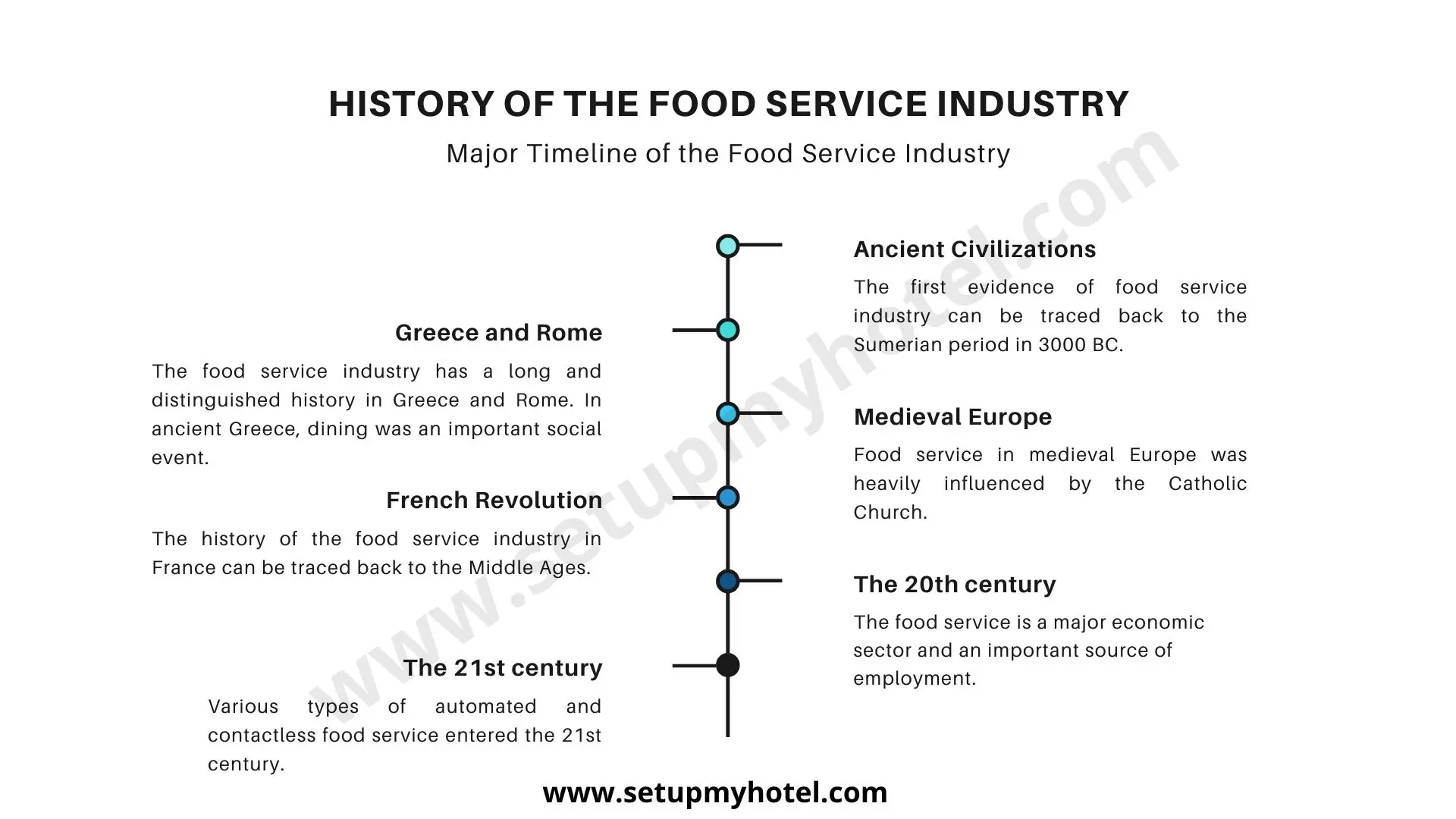History Of The Food Service Industry
The Introduction:
One of the most fascinating developments in the history of food service is the way that each successive generation has shaped it. Food service has developed and evolved over the centuries, with many new ways of preparing and serving food emerging in recent years.
The development of airport food service is one example. In the past, it was common for travellers to rely on local restaurants for their meals when travelling by plane. Today, travellers can find food service at many airports where they can order and eat from a menu that includes a wide variety of offerings.
Ancient Civilizations:
The first evidence of the food service industry can be traced back to the Sumerian period in 3000 BC. Back then, food service was mainly provided by temples and palaces. They employed professional cooks and served food to the nobility and guests.
In the following centuries, the food service industry grew rapidly and became an important part of the economy. There were now many restaurants and inns catering to different segments of the population.
The quality of food also improved as cooks began to use more sophisticated methods and ingredients. By the end of the Roman period, food service had become a sophisticated business with a large variety of establishments catering to different needs and tastes.
Greece and Rome
The food service industry has a long and distinguished history in Greece and Rome. In ancient Greece, dining was an important social event. Guests would recline on couches or sit at communal tables to share food and conversation. Wealthy citizens would even have private dining rooms.
Elite families would hire professional cooks and waiters to provide them with fine meals. Ancient Greeks were also the first to serve wine with their meals. Romans adopted Greek dining customs, adding their twists.
The Roman Empire was so powerful that its cuisine spread throughout the Mediterranean world. After the fall of the Roman Empire, the food service industry in Europe declined because there was no central government to support it.
Medieval Europe:
Food service in medieval Europe was heavily influenced by the Catholic Church. Religious holidays and ceremonies were a big part of the food service industry, and the Church played a large role in regulating what people ate.
Several guilds controlled the food service industry, and these guilds regulated everything from who could provide food services to what could be served.
French Revolution
The history of the food service industry in France can be traced back to the Middle Ages. At that time, taverns and inns were the main places where people could enjoy a meal. Over time, restaurants began to appear, and the industry grew rapidly.
One reason for France’s dominance in this field is its tradition of gastronomy. French chefs are considered among the best in the world, and their cuisine has become famous all over the globe. Moreover, French restaurants are often very elaborate and luxurious, offering something for everyone.
The 20th century:
Today, food service is a major economic sector and an important source of employment. Foodservice is expected to grow faster than the average for all industries over the next decade.
The 21st century (Present):
Various types of automated and contactless food service entered the 21st century. Contactless food service, QR menu technology, and robotic food service are a few examples.
Conclusion: The history of food service is fascinating and varied, and it is sure to continue evolving in the years to come.
Here is a brief overview of key developments in the evolution of the food service industry:
- Ancient Civilizations:
- The roots of the food service industry can be traced back to ancient civilizations, where inns and taverns provided meals and accommodations to travellers. Ancient Rome had thermopolia, which were establishments where hot food and drinks were sold.
- Medieval Europe:
- During the Middle Ages, the concept of the restaurant as we know it today began to take shape. Public eateries, known as “cook shops,” started emerging in major European cities, offering simple meals for purchase.
- Renaissance:
- The Renaissance period saw the rise of the formal restaurant in France. In 18th-century Paris, establishments like Boulanger and Beauvilliers gained fame as places offering soups and other “restaurants” or “restoratives.”
- Industrial Revolution:
- The Industrial Revolution brought significant changes to the food service industry. With urbanization and the growth of the middle class, more people sought meals outside the home. The emergence of cafes and restaurants became more widespread.
- Railroad and Travel:
- The expansion of railroads and travel in the 19th century further fueled the food service industry. Railway dining cars and station restaurants catered to travellers, contributing to the standardization of meals.
- 20th Century:
- Fast food gained prominence in the mid-20th century with the rise of chains like McDonald’s, KFC, and Burger King. This era also saw the development of the franchise model, leading to the globalization of certain food service brands.
- Fine Dining and Culinary Excellence:
- In the latter half of the 20th century, the food service industry witnessed a surge in fine dining establishments. Renowned chefs like Julia Child and the rise of culinary schools contributed to a greater emphasis on culinary excellence.
- Technology and Delivery:
- The late 20th century and early 21st century brought technological advancements, influencing the food service industry. Online ordering, food delivery apps, and digital marketingA system of interrelated activities formulated to plan; price; promote and make available the servic... have become integral components of many establishments.
- Health and Sustainability Trends:
- In recent years, there has been a growing emphasis on health-conscious eating, organic ingredients, and sustainable practices. Consumers are increasingly interested in the source of their food and its impact on the environment.
- GlobalizationGlobalization is the increased mobility of goods; services; labor; technology and capital throughout...:
- The food service industry has become highly globalized, with a fusion of culinary influences from around the world. International cuisines are more accessible, and restaurants often showcase diverse culinary traditions.
- Pandemic Impact:
- The COVID-19 pandemic significantly impacted the food service industry, leading to increased reliance on takeout and delivery services, the adoption of contactless technologies, and a renewed focus on safety and hygiene.
The history of the food service industry reflects societal changes, technological advancements, and evolving consumer preferences. From humble beginnings to a complex and diverse landscape, the industry continues to adapt and innovate in response to shifting trends and demands.











